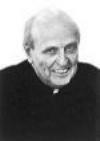|
Issue Date: December 19, 2003
After the wedding, the church is challenged to help couple stay together By ROBERTS F. DRINAN I recently presided and preached at a wedding. It was an exhilarating, sublime and awesome experience. The bride was a Catholic; the groom was not raised in any religious tradition. They obtained a dispensation and were married at a Mass. Audiences at weddings are always receptive. Everyone in the church inevitably reflects on the state of their own marriage. The divorced probably have some regrets, some doubts and some frustrations. In my homily at marriages I often urge those who are married to hold each other’s hands and recite with the bride and groom the words by which they pledge their loyalty to each other for “the rest of their lives.” After the ceremony, the married in the congregation often tell me that the renewal of their vows was a meaningful and even mystical experience. Many people at a wedding in a Catholic church pray that the marriage being performed will not be one of the 33 percent or more of Catholic marriages that end in divorce. One non-Catholic man at a recent marriage at which I preached told me that he was impressed at the beauty of the ceremony and the extent to which the church made clear that marriage is forever. He had never heard before, he told me, the striking message in the liturgy that God blesses and sanctifies the intense human love that the bride and the groom have for each other. It is encouraging to note that virtually every couple preparing for Catholic marriage with whom I have talked is impressed by the pre-Cana instructions they receive. The Catholic church is really trying to help couples to understand and appreciate the responsibilities they undertake in entering into a permanent contract which, absent extraordinary circumstances, cannot be rescinded. The role of the priest in a Catholic marriage is not really central. He witnesses the formation of a contract that is based in civil law. But the presence of the priest is cherished by Catholics marrying in the church. Many couples really want a priest who is a friend. Some priests tend to decline invitations to preside at a wedding because it involves a long weekend. I tend to accept when I can. I think of the saying of the late Jesuit Fr. John LaFarge when he spoke of the “apostolate of presence” for priests. Just by being present, priests let people know that the church is present and active. One of the many satisfactions a priest receives at a marriage is the delight and peace of parents who see their children, after long years of absence from the church, reenter the church for their wedding. The parents hope that the ceremony and the congregation standing with applause for the bride and groom will re-ignite all of the faith in the church that the parents have communicated to their child over some 30 years. Marriages often result in Christmas cards for the priest. People want to express their gratitude for a spiritual experience. Families are indeed sometimes transformed. There is a new love born among in-laws. And the priest is somehow a part of the new togetherness. It is painful when a priest learns that those whose marriages he witnessed are getting divorced. Could he or the Catholic church have done more? Will one of the newly separated spouses want an annulment? Marriage in the United States appears to be in crisis. America may have a higher divorce rate than any nation in the world. What more can the church do to help Catholics married in the church to live up to their promise to love each other “until death do us part”? The question is one of the most urgent issues before Catholic leaders today. Every wedding is a source of grace for all who are present. But the deepest mystery of marriage is sometimes neglected. Marriage is a reflection and a replica of the union between Christ and his church; Christ is the bridegroom and the church is his bride. This relationship is not a metaphor or an analogy. It is a reality. But it is mystical. I have seldom been able to make this a real and vital part of a marriage ceremony. But it is a reality that makes every union of husband and wife into something transcendental with a supernatural meaning that is almost beyond understanding. Jesuit Fr. Robert Drinan is a professor at Georgetown University Law Center. His e-mail address is drinan@law.georgetown.edu. National Catholic Reporter, December 19, 2003 |
 The mystery of marriage
The mystery of marriage